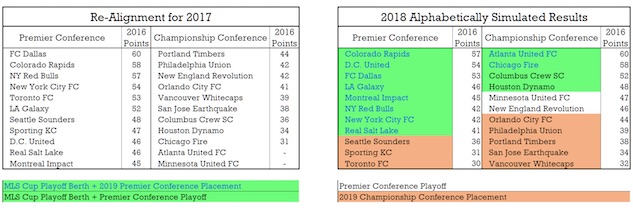Promotion and Relegation the American Way: How MLS Can Implement Pro/Rel Right Now
Photo by Victor Decolongon/Getty
Even in their darkest hour, the Pro/RelBros of America’s soccer fandom are claiming a sad sort of triumph. To them, the collapse of the New York Cosmos—and potentially the NASL along with it—proves the U.S. federation has been rigged by the moneyed elites of MLS & Soccer United Marketing. The common fan has yet again been denied their right to support a grassroots club’s push to join the top flight.
In reality, an implosion of the second division proves the opposite: U.S. soccer—both the sport and the federation that represents it in America—is not ready for full promotion and relegation, and may never be.
Nevertheless, Pro/RelBros continue to heap social-media scorn on anyone who suggests it’s not “realistic” or “pragmatic” to implement promotion and relegation between tiered leagues here—just look how well they work in Scandinavia!. But take a moment and put yourself in the shoes of a Kroenke or a Kraft, watching the NASL go down in flames and thanking their lucky stars their nine-figure MLS investment isn’t being burned along with it.
It’s indisputable: MLS is stronger together, without the threat of relegation to a lower tier for its member clubs.
At the same time, pro/rel supporters have a point. The demand has never been higher for professional soccer in the U.S., and MLS is woefully underserving the market, missing out on a generation of fans who are buying jerseys of foreign leagues and teams. There are a host of regions and cities who want top-flight soccer, and quite a few MLS cities who have no reason to watch once it’s clear their club is going to be a bottom-table side.
But I’ve got an idea that achieves most of the goals of the pro/rel crowd without threatening the pocketbooks of American soccer’s bourgeoisie, one that re-aligns MLS by performance instead of geography:

It’s simple: the MLS’ top 11 teams by points from the 2016 league table will start in the high conference, called “Premier” here for clarity’s sake. Meanwhile the bottom nine start in the “Championship,” along with expansion clubs Atlanta United FC and Minnesota United FC. Both conferences would play a double round-robin within their conference, and a single round-robin against the other conference teams.
And here’s the twist: the top eight finishers in the Premier Conference would receive bids in the MLS Cup Playoffs, while only the top four from the Championship Conference would get a berth.
This is the only real pain point, the only differentiator between “high” and “low”. All 22 teams will still be first-division sides, single-entity would remain in effect and nobody loses out on any TV money. When the bottom three Premier teams are “relegated” in 2018, the franchise values won’t be cut in half, nor would there be a fire sale of all the teams’ best players.
MLS is uniquely positioned to pull this off. The regular-season table and Supporter’s Shield carries more weight with fans and media than in other North American leagues like the NHL and the NBA. The fact that teams will the season with either a 73 percent or 36 percent chance of making the postseason tournament doesn’t render their regular-season campaign pointlessly easy or difficult.
-

-

-

-

-

-

-

-

-

-

-

-

-

-

-

-

-

-

-

-

-

-

-

-

-

-

-

-

-

-

-

-

-

-

-

-

-

-

-

-








































